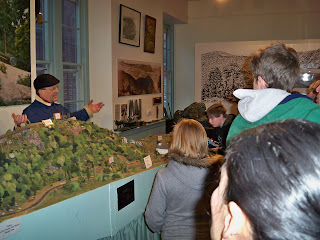It always starts with a problem.
How do we engage our youth?
How do we ply them from the techno gizmos and introduce them to the outside, to engage that exploring spirit?
Perhaps the answer lies within the man who seemed to have a great combination of imagination, energy, and focus.
His name was Josiah White and he was born in Mt. Holly New Jersey in 1781.
He grew up on a farm and explored the surrounding waterways. One can only imagine what dreams he dreamed. But he explored, he imagined, he innovated. The result, some have said, that it became his hand that rocked the cradle of the Industrial Revolution.

Josiah dreamed of riches, enough to retire by age 30, to live the will of his maker and retire to the quiet life of his farm. He had those riches by the time he was 28, he owned a wire-mill in Philadelphia and fortunately for us, he continued on.
The War of 1812 taught this Quaker, that one shouldn't rely on a foreign fuel supply. The British blockade and embargo hampered our industrial output. And soon, Josiah was planning and surveying Pennsylvania's first railroad, the second oldest in the country. By 1818, he set out to do what two other groups had failed to do: bring the rich hard, blue burning anthracite down from the veins of Summit Hill and Lansford.
The Switchback Railroad was also our first rollercoaster, reaching speeds in excess of 50 miles per hour. It was innovative. It was brought to us by an engaged mind.
And today, the youth of our county have seen with their own eyes what started with one man's imagination. Students from Lehighton Area Middle School, recently walked to the top of Front Hill, Jim Thorpe and entered the Switchback trail. They saw where the train station rested atop the long embanked walkway. They imagined the clickity-clack of the cars ambling down the 9-miles from Mt Jefferson and later heard the actual engine house bell ring. They explored and hopefully ignited a life long quest for thinking, for innovating in their own lives.

They arrived at the Mauch Chunk Museum and Cultural Center
(See: http://mauchchunkmuseum.com/ ) and were thrilled to see in miniature, the entire Switchback, including it's engine houses and some real artifacts. Mike Nonnemacher made the journey come to life: how the barney cars pushed, how it was America's second leading tourist attraction (behind Niagara Falls), how it fell to disrepair in the Depression, sold for scrap, and "came back as bullets" when it was bought by the Japanese in 1937.
How do we engage our youth? It all starts with a problem. Do we have the energy and focus to overcome it? Hike the trail. Engage them. Perhaps what started so long ago may help spur a youth's future innovation. Perhaps new entrepreneurs are now ready to pick up Josiah's mantle.
Over 50 students and parents of 5th Graders at Lehighton Area Middle School have set out on four tours of the trail, immersing themselves in our partially forgotten history. Three more evening tours are scheduled.
The Mauch Chunk Historical Society also sponsors history tours of Jim Thorpe as well. These local-historian led tours meet at the NJC RR Station every Saturday and Sunday at 11 AM, 1 PM, & 3 PM. Donations are $10 per adult & $5 per child under 10. Bill Allison is in charge of the tours and you may contact him at 610-457-0370. If you would like to know when I am scheduled to give these tours, you can contact me at
rabenold@ptd.net or C. 610-428-6651.


















